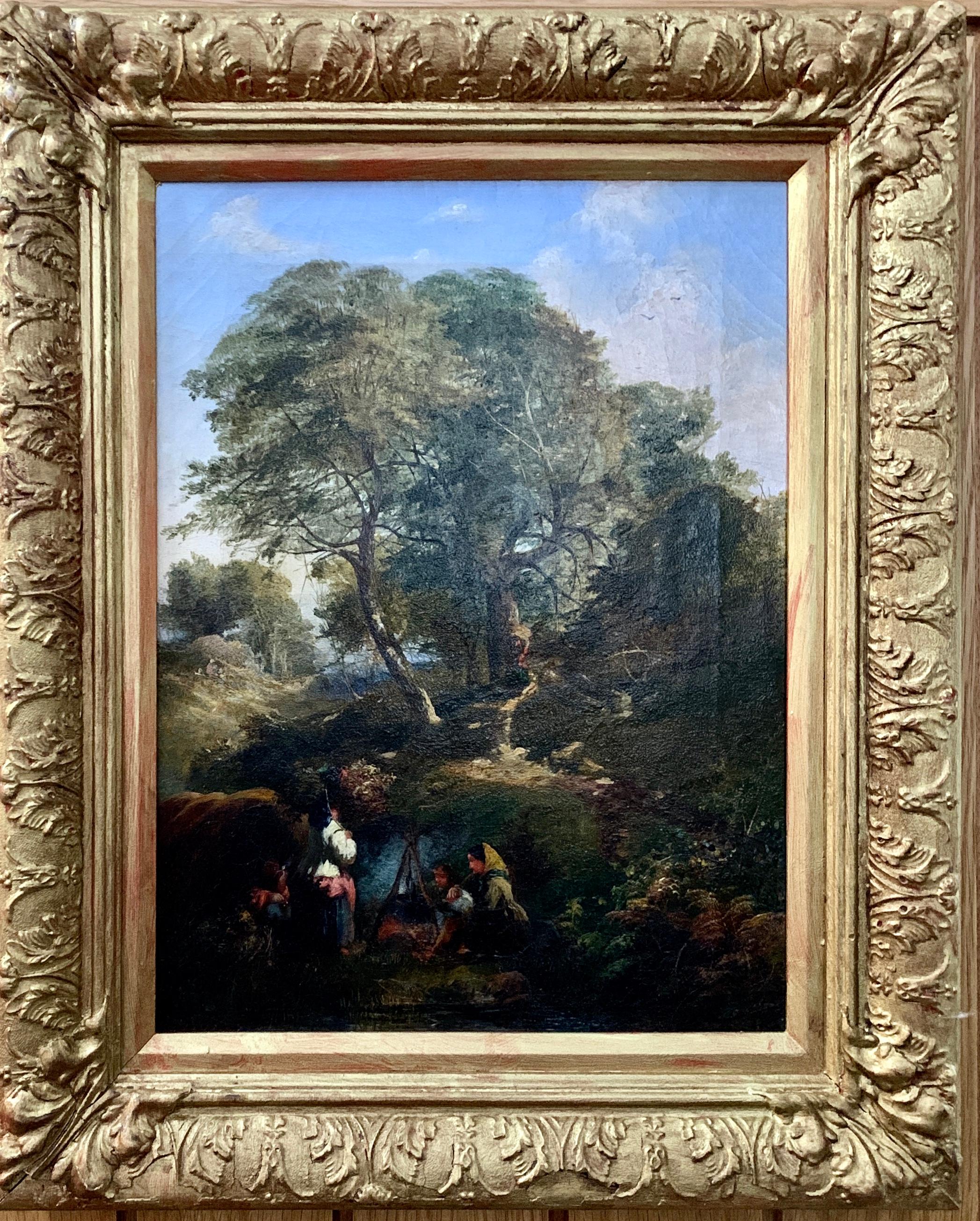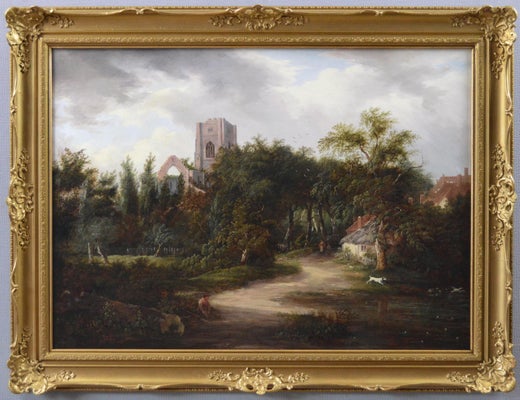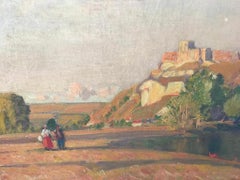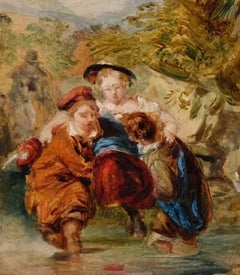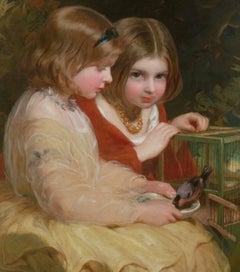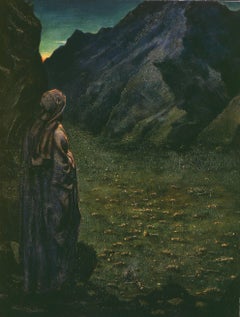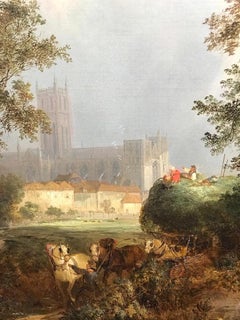
Landscape with Cathedral, An English 19th Century Landscape
View Similar Items
Edward WilliamsLandscape with Cathedral, An English 19th Century Landscape
About the Item
- Creator:Edward Williams (1782 - 1855, English)
- Dimensions:Height: 40.16 in (102 cm)Width: 35.04 in (89 cm)
- Medium:
- Movement & Style:
- Period:
- Condition:
- Gallery Location:Lincoln, GB
- Reference Number:1stDibs: LU80513880772
Edward Williams
Edward Williams, born in London in 1781, was an English landscape painter during the Victorian era. He had six sons, who became well-known landscape painters as well. He came from a family of artists — his mother, Mary Ward, was the sister of the animal painter James Ward and the engraver William Ward, but also the sister-in-law of the figure-painter George Morland, and of the animal painter Henry Chalon; his father was an engraver who worked with John Raphael Smith. Edward Williams was sent around 1792 or 1793 to live with his maternal uncle James Ward, R.A. (1769–1859), but it seems unlikely that he received any painting instruction from him. Instead, he was informally apprenticed to a carver and gilder named Thomas Hillier, who had a shop on Carnaby Street and he became quite successful to enjoy a comfortable living. Williams between 1814–55 exhibited at the Royal Academy of Arts (36 works), British Institution (21 works), Suffolk Street Gallery of the Society of British Artists (38 works), and elsewhere. He started by painting miniatures and copying Baroque landscapes from the 1600s in the style of the Dutch painters Ruisdael (1628–82) and Hobbema (1638–1709), the former known for woodland scenes with detailed renderings of trees, particularly the leaves, and water scenes with small boats moored beneath windmills; the latter known for his densely foliated trees with stippled leaves. As Williams developed his style, in which the figures, if present at all, were generally subordinate to the scenery, he moved on to contemporary landscapes of the English countryside that, not surprisingly, a hint of some of the work of his uncle George Morland.
- Chateau Gaillard, On The Seine A 19th Century French LandscapeBy Alfred EastLocated in Lincoln, GBSir Alfred East RA (1844-1913) Château Gaillard, on the Seine oil on canvas Signed 71 x 91cm (27 15/16 x 35 13/16in) Sir Alfred East was born in 1844 ...Category
Late 19th Century Barbizon School Landscape Paintings
MaterialsOil
- Crossing The Ford An Oil Study for the Original by W Mulready, Tate BritainBy William MulreadyLocated in Lincoln, GB‘Crossing the Ford’ by William Mulready (1786-1863) Oil Sketch. Size: 28cm x 23cm framed. Image size: 17cm x 13cm William Mulready was born in Ennis, County Clare...Category
19th Century Old Masters Figurative Paintings
MaterialsOil
- The Pet Bullfinch, A Portrait of Two Children by James Sant 19th / 20th CenturyBy James SantLocated in Lincoln, GB‘The Pet Bullfinch’ James Sant CVO RA (1820-1916) oil on canvas 30 x 25 in. (76.2 x 63.5 cm.) James Sant was a well known Victorian painter particularly of women and children, as both portraits are allegorical subjects, i.e. a painting that can be interpreted to have a hidden meaning, often political or moral. Sant exhibited at the Royal Academy and in 1871 was appointed Principal Painter in Ordinary by Queen Victoria, having painted many portraits of the Royal children. One of his most famous being that of Prince Leopold and Princess Beatrice...Category
20th Century Victorian Portrait Paintings
MaterialsOil
$23,731 Sale Price35% Off - Regency Sisters, A Portrait of Two Children - Fredrick Yeates HurlestoneBy Frederick Yeates HurlestoneLocated in Lincoln, GBFrederick Yeates Hurlestone (1800 – 1869) Regency Sisters Oil on Canvas Size: 153cm x 126cm framed Frederick Yeates Hurlstone (1800 - 1869) was an English portrait and historical painter. Hurlstone exhibited at the Royal Academy for many years. He was a member of the Society of British Artists and was President of the Society until his death. He was born in London, the eldest son by his second marriage of Thomas Y. Hurlstone, one of the proprietors of the "Morning Chronicle" (his granduncle, Richard Hurlstone, was a well-known portrait-painter a generation earlier). He began life in the office of his father's journal, but, while still very young, became a pupil of Sir William Beechey, afterwards studying under Sir Thomas Lawrence, and also, it is said, under Benjamin Haydon. His first original work was an altar-piece, painted in 1816, for which he received 20 pounds. In 1820 he was admitted as a student of the Royal Academy, where in 1822 he gained the silver medal for the best copy made in the school of painting, and in 1823 the gold medal for historical painting, the subject being "The Contention between the Archangel Michael and Satan for the Body of Moses". He first exhibited in 1821, sending to the Royal Academy "Le Malade Imaginaire" and to the British Institution a "View near Windsor". These were followed at the Academy in 1822 by "The Return of the Prodigal Son" and a portrait, in 1823 by five portraits, and in 1824 by his "Archangel Michael" and some more portraitsOne of his best early works was "A Venetian Page with a Parrot", exhibited at the British Institution in 1824. In 1824 also he contributed "The Bandit Chief" to the first exhibition of the Society of British Artists. He continued to send portraits to the Royal Academy until 1830, but in 1831 he was elected a member of the Society of British Artists, after which he seldom exhibited elsewhere. He was chosen president in 1835, and again in 1840, retaining the office until his death. He contributed to the society's exhibitions upwards of three hundred portraits and other works, among them being "The Enchantress Armida", exhibited in 1831; "Haidee aroused from her Trance by the sound of Music", 1834; "Eros", 1836; "Italian Boys playing at the National Game of Mora" and the "Prisoner of Chillon", 1837; "The Scene in St. Peter's, Rome, from Byron's Deformed Transformed", 1839; "The Convent of St. Isidore: the Monks giving away provisions", 1841; and a "Scene in a Spanish Posada in Andalusia", 1843. In 1844 and, for the last time, in 1845 he again sent portraits to the Academy. His subsequent works at the Society of British Artists included "The Sons of Jacob bringing the blood-stained garment of Joseph to their Father", 1844; "Salute, Signore", 1845; "A Girl of Sorrento at a Well", 1847; "Inhabitants of the Palace of the Cæsars—Rome in the Nineteenth Century" 1850; "Columbus asking Alms at the Convent of La Rabida" 1853; "The Last Sigh of the Moor" (or "Boabdil el Chico...Category
19th Century Victorian Figurative Paintings
MaterialsOil
$39,456 Sale Price20% Off - Cattle Watering by Charles 'Sheep' Jones (1836-1892)By Charles Jones (b.1836)Located in Lincoln, GBCattle Watering Charles Jones (1836 – 1892) Signed with monogram, dated ’62 (lower right) Oil on canvas 69cm x 58.5cm Framed size 93cm x 82cm Charles 'Sheep' Jones was a London pain...Category
Late 19th Century Victorian Animal Paintings
MaterialsOil
- Going To Market A Large English Genre Scene with CattleBy Charles CollinsLocated in Lincoln, GBAlfred Jerome Charles Collins (1851-1921) Going To the Cattle Market 176 x 88cm Canvas / 198 x 110cm frame This exceptionally impressive work has a romanticism attached to it, wit...Category
Early 20th Century Victorian Animal Paintings
MaterialsOil
$18,959 Sale Price20% Off
- Carnevale di Venezia - Large 19th Century Oil Painting of Venice Italy CanalettoBy James HollandLocated in Gerrards Cross, GB‘Carnevale di Venezia’ by James Holland RWS (1799-1870). The painting – which depicts an extensive view of the Grand Canal with hundreds of masked revellers before the Ducal Palace ...Category
Mid-19th Century Victorian Landscape Paintings
MaterialsOil
- Carnevale di Venezia - Large 19th Century Oil Painting of Venice Carnival ItalyBy James HollandLocated in Gerrards Cross, GB‘Carnevale di Venezia’ by James Holland RWS (1799-1870). The painting – which depicts an extensive view of the Grand Canal with hundreds of masked revellers before the Ducal Palace ...Category
Mid-19th Century Victorian Landscape Paintings
MaterialsOil
- Ezekiel in the Valley of Dry BonesBy Philip Burne-JonesLocated in New York, NYProvenance: Christie’s, London, 3 March 1922, lot 46 (with The Tower of Babel); James Nicoll Private Collection Sotheby’s, London, 29 March 1983, lot 157 Private Collection, New Yo...Category
Late 19th Century Victorian Figurative Paintings
MaterialsOil, Canvas
- 1830's English Oil Storm Clouds Norfolk Landscape Norwich Cathedral River YareBy (Circle of) John ConstableLocated in Cirencester, GloucestershireStorm Clouds over the River Yare *see notes below English School, circa 1830's circle of John Constable (English 1776-187) oil painting on canvas, framed canvas: 18 x 25 inches condi...Category
Early 19th Century Victorian Landscape Paintings
MaterialsCanvas, Oil
- Large Victorian painting of children resting outdoors by J.O. BanksLocated in London, GBLarge Victorian painting of children resting outdoors by J.O. Banks English, late 19th Century Frame: Height 91cm, width 111cm, depth 10cm Can...Category
19th Century Victorian Landscape Paintings
MaterialsCanvas, Oil
- The Woodman's Family in a Landscape - British 1869 Victorian art oil paintingBy Edward Charles WilliamsLocated in London, GBThis lovely British Victorian oil painting is by Edward Charles Williams of the Williams Family of artists and related to George Morland. The painting is a figurative landscape entitled the Woodman's family and entails five figures and a dog gathered around a tree that the Woodman is tackling with his axe. The painting is signed and indistinctly dated (only visible with ultra violent light) lower left, the date being 1869. For me, the highlight of the painting is the artistry and attention to detail with which Williams has portrayed the light on the trees above and the exquisite colouring of the leaves. There are even two birds finely depicted in the tree foliage. Signed and indistinctly dated 1869 lower left (only visible under ultraviolet light). Provenance. Berkshire estate. Condition. Oil on canvas, image size is 40 inches by 36 inches and in good condition. Housed in a complementary frame. Framed size is 48 inches by 44 inches and in good condition. Edward Charles Williams (London 10 July 1807 – 25 July 1881) was an English landscape painter during the Victorian Era, and a member of the Williams family of painters. He was the eldest son of the painter Edward Williams (1781–1855) and Ann Hildebrandt (c.1780–1851), and a member of the Williams family of painters, who were related to such famous artists as James Ward RA and George Morland. His father was a well-known landscape artist, who taught him how to paint; otherwise he received no formal instruction. He adopted much of his father's style and technique, and like the other painters of his family, he devoted himself to landscapes, producing rich and tranquil views of Barnes, Cumberland, Kent, Surrey and the Thames. His paintings are now highly sought after. Williams married his first wife Mary Ann Challenger on 11 December 1839 in Westminster. Mary Ann died in 1857 in London, and his only child Alice Williams was born shortly afterwards to Sarah Susannah Horley, who had been Mary Ann's nurse – Edward and Sarah did not marry for another 10 years until 3 October 3, 1868, when they wed at the St. Pancras Old Church in Camden, London. He largely stopped painting after the 1859 death of his second wife, adding value to the small number of paintings that he did produce from 1859 on − Springer in the Bracken, The Lap Dog, The Ploughman's walk home, The Ducks at Tilbury and Primrose at St Mary's (Primrose was the Verger's Cat). Some suggest that he suffered a breakdown after his wife's death, given his choice of subjects in these later years. The location of three of these post-1859 works are unknown, and they are assumed lost during two world wars. He signed some of his work as E Williams, which leads to confusion with his father, who painted in a similar style, and at times he signed as C Williams to purposely avoid such confusion. Because many of the paintings of both father and son are unsigned, it can be difficult to correctly attribute their work. Edward Charles also collaborated on several paintings with William Shayer, where Williams would paint the landscape, and Shayer would add in figures and animals; his Near Wantage, Berkshire is a good example. He died 25 July 1881 at Shepherds Bush in London and is buried with Sarah Horley and their daughter Alice in Hammersmith Old Cemetery, close to other family graves. Edward Charles Williams was born into an artist family that is sometimes referred to as the Barnes School. His father and five surviving brothers were all noted landscape painters during the Victorian era. Three of the sons of Edward Williams changed their last names to protect the identity of their art. Edward Williams (father) Henry John Boddington, George Augustus Williams, Arthur Gilbert, Sidney Richard Percy, Alfred Walter Williams.Category
19th Century Victorian Landscape Paintings
MaterialsOil









